Do you struggle to fall asleep at night, tossing and turning as your mind races? You’re not alone. Up to a third of adults have experienced sleep troubles at some point. Stress, pain, or anxiety often cause these problems. But what if there was a simple technique to help you sleep better?
Enter sleep meditation – a practice that can prepare your mind and body for a peaceful night’s sleep.
Sleep meditation uses tools like guided visualizations and calming breath work. These tools help move your body out of the “fight-or-flight” mode that can disrupt sleep. By using these techniques, you may find relief from insomnia, ease racing thoughts, and even improve your brain health.
But how exactly does sleep meditation work, and how can you incorporate it into your nightly routine? Let’s explore the science behind this powerful practice.
Understanding Sleep Challenges in Modern Life
In today’s fast world, sleep disorders are common. 30-50% of people worldwide report occasional insomnia, and up to 10% of the population has chronic insomnia. Many things can disrupt sleep, like physical issues and technology use.
Common Sleep Disruption Factors
Many things can make sleep poor. Medications, substances like caffeine or alcohol, and health issues are common disruptors. Also, stress, anxiety, and depression can make it hard to sleep well.
Impact of Technology on Sleep Quality
Digital devices have made sleep harder. The blue light from screens can keep the brain awake. The CDC says 9 million Americans take sleep meds, showing how big the sleep problem is.
Statistics on Sleep Problems
Poor sleep has big health risks. It can lead to heart disease, stroke, depression, and obesity. With so many people struggling, finding good sleep solutions is key.
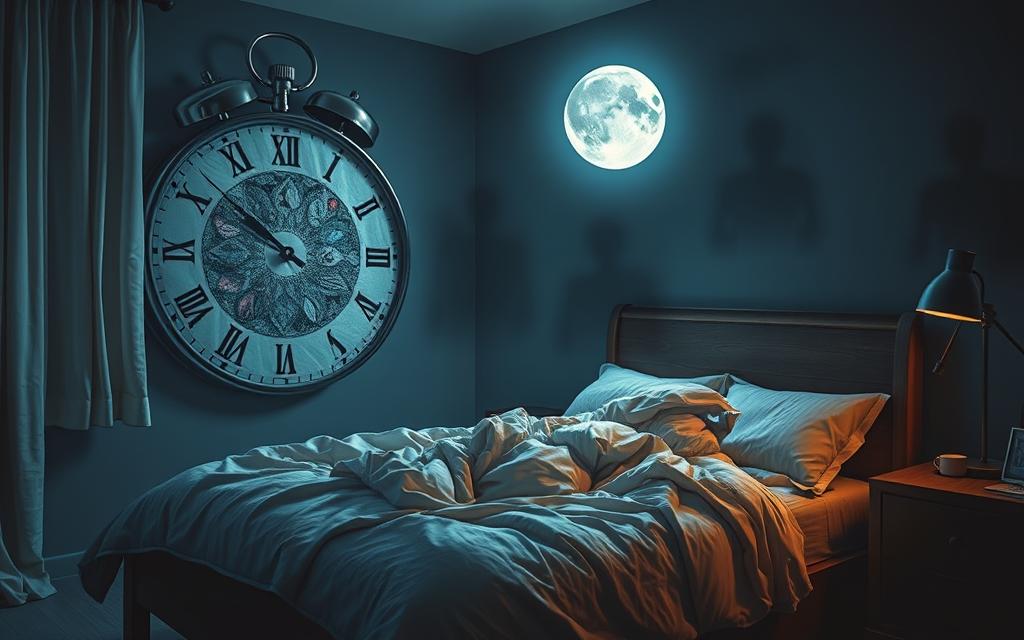
The Science Behind Sleep and Rest
Getting enough sleep is key for staying healthy. Adults need 7 or more hours of sleep each night. This helps with growth, waste removal, and balancing brain chemicals. Sleep also helps with learning and remembering things.
The circadian rhythm controls when we sleep and wake. It’s influenced by light and melatonin. Shift workers often face big problems because their rhythm gets messed up. This can lead to heart disease, weak immune systems, and higher diabetes and obesity risks.
Good sleep cycles have different stages, like deep slow-wave sleep. Research shows that meditation can improve sleep quality. It helps increase slow-wave sleep, which is better for experienced meditators.
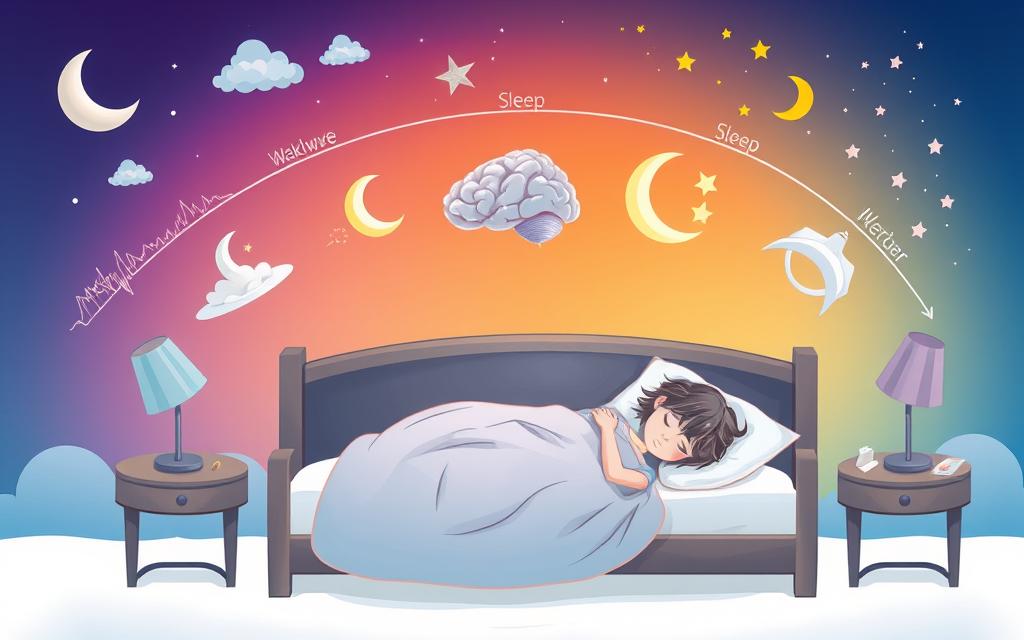
“Even being off by as little as two hours of sleep regularly can affect physiology and mental state over time.”
Keeping a good sleep schedule is hard in today’s world. Too much screen time, eating late, and irregular routines harm sleep. But, sticking to a routine, avoiding screens before bed, and using meditation can help. These steps support better, more restful sleep.
What is Meditation for Sleep
Meditation is a great way to get better sleep and feel better overall. It includes guided sessions, relaxation exercises, and deep breathing. These help quiet your mind and relax deeply.
The main goal is to release daily stress and worries. This creates peace and calm, making it easier to sleep well.
Core Principles of Sleep Meditation
The core of sleep meditation is the relaxation response. It’s a state that fights stress. By calming the mind and body, it lowers heart rate and blood pressure.
It also reduces stress hormones and boosts serotonin, which helps you sleep.
Different Types of Sleep Meditation
- Body Scan Meditation: Focuses on relaxing each body part one by one.
- Visualization: Uses mental images to calm and relax.
- Breath Meditation: Uses breath as a focus for the mind.
- Loving-Kindness Meditation: Builds compassion and kindness.
- Humming Meditation: Uses humming to enter a meditative state.
How Sleep Meditation Affects the Brain
Sleep meditation deeply affects the brain. It triggers the relaxation response, reducing stress and anxiety. It also boosts serotonin and melatonin, key for sleep.
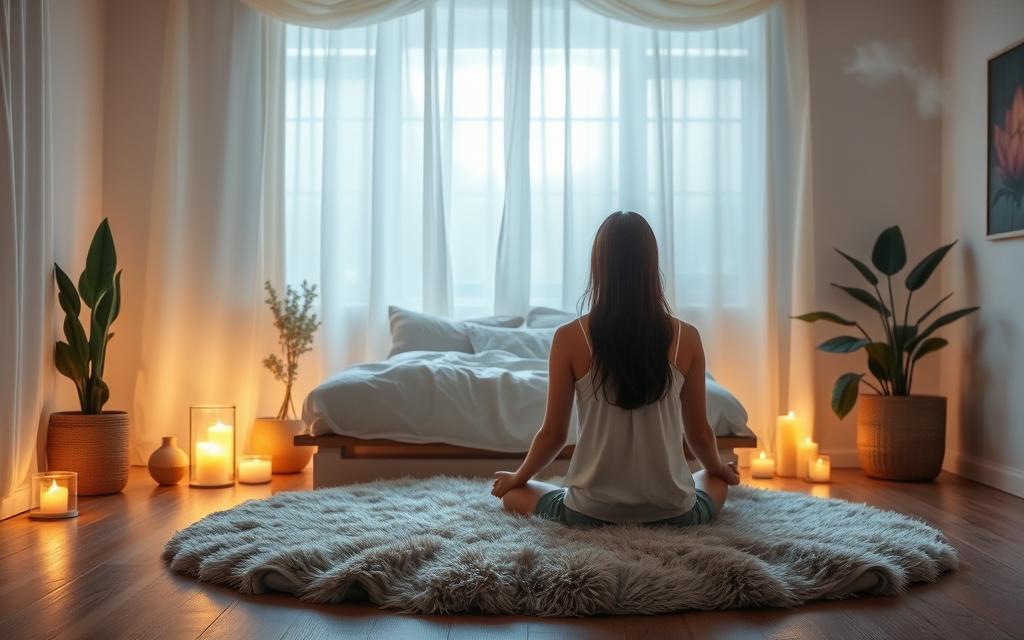
“Meditation is not about forcing yourself to be somewhere you’re not. It’s about gently coming back, over and over again, to the breath, to the present moment.” – Sharon Salzberg
Adding mindfulness meditation and guided sleep meditation to your bedtime routine can greatly improve sleep. Understanding sleep science helps you take steps to better sleep and health.
Benefits of Practicing Sleep Meditation
Adding sleep meditation to your daily routine can greatly improve your well-being. It helps you sleep better, feel less stressed, and boosts your mental health.
One key benefit is better sleep. Sleep meditation uses techniques like body scanning and breath work. These help you relax and sleep soundly.
It also helps reduce stress. By focusing on the now, you let go of worries that keep you awake. This makes you feel calmer and more in control.
But sleep meditation’s benefits don’t stop at sleep. It can also improve your mental health. Studies show it can lower depression and anxiety symptoms. It helps you feel more at peace.
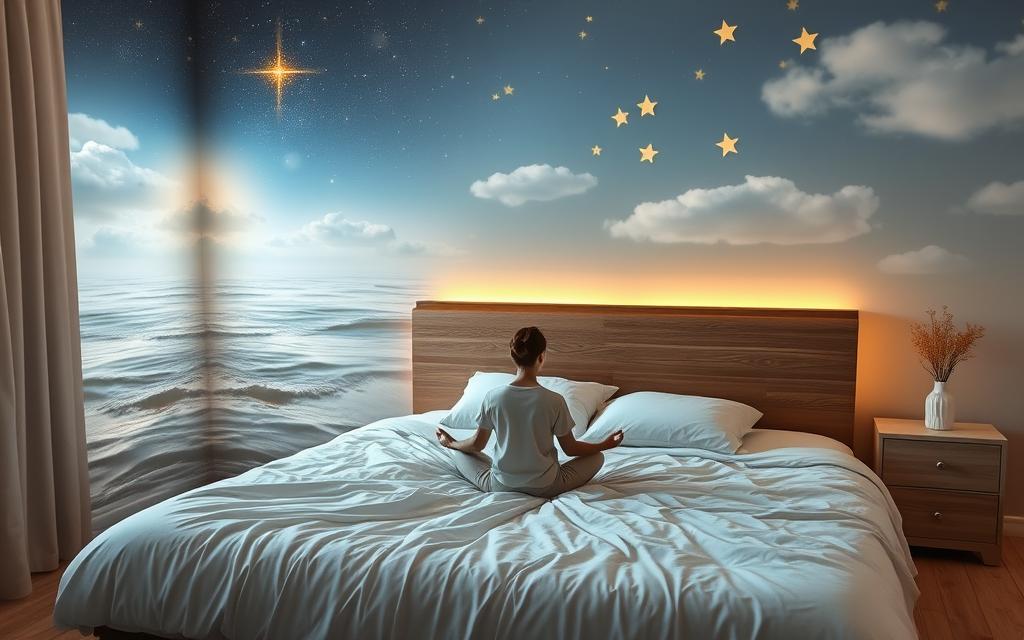
“Meditation is not about becoming a different person, a new person, or even a better person. It’s about training in awareness and understanding who you already are.” – Pema Chödrön
Exploring sleep meditation can be incredibly rewarding. With regular practice, you’ll find more calm, clarity, and connection. These can lead to a more fulfilling life.
Understanding the Mind-Body Connection for Better Sleep
Getting quality sleep is key for our health and happiness. But, many people face sleep issues. The link between our mind and body greatly affects how we sleep. Stress, a big sleep disruptor, can harm our body and make it hard to sleep.
Role of Stress in Sleep Disruption
Stress can make our heart race, tighten muscles, and release hormones like adrenaline. These changes make it tough to fall and stay asleep. Chronic stress also weakens our immune system, raises heart disease risk, and can upset our stomachs, making sleep worse.
How Meditation Influences Sleep Hormones
Meditation and mindfulness can help the mind-body connection and improve sleep. It activates the parasympathetic nervous system. This lowers cortisol and boosts sleep hormones like melatonin, helping us sleep better.
“Regular practice of meditation and mindfulness leads to improved sleep quality, stress reduction, and enhanced emotional resilience.”
Research shows meditation can greatly improve sleep. It’s more effective than many other sleep treatments. Meditation tackles the root causes of sleep issues, balancing the mind and body for better sleep and sleep quality.

Essential Body Scan Techniques
Getting a good night’s sleep is hard in today’s fast world. Body scan meditation is a powerful tool to help. It involves focusing on each part of your body, from head to toe. You note any feelings without trying to change them.
This practice helps shift your focus from worries to the present moment. It can calm your mind and get your body ready for deep sleep.
Body scan meditation often pairs with progressive muscle relaxation. You tense and then relax each muscle group. This combo helps release tension and leads to deep relaxation.
Studies show it can lower stress, reduce cortisol, and improve sleep. It’s a great way to boost your overall health.
To add body scan meditation to your evening, try 15-20 minutes each night. Begin with deep breathing, then scan your body, noticing any sensations. You can also try mindfulness exercises or guided scans to enhance your experience.
“By practicing body scan meditation, you can become more aware of your body’s signals and respond more effectively to relieve tension and improve your overall mental and physical well-being.” – Jon Kabat-Zinn, mindfulness expert
Adding body scan meditation to your evening routine can greatly improve your sleep. Combine it with other relaxation methods like breathwork and visualization. Consistency is key, so make it a regular part of your life. You’ll see the positive changes for yourself.

Breathing Exercises for Deep Sleep
Getting quality sleep is key for our health, but many face sleep issues today. Luckily, simple breathing exercises can help. They calm the mind and body, making it easier to sleep well.
The 4-7-8 Breathing Method
The 4-7-8 breathing method is a favorite for sleep. You breathe in for 4 counts, hold for 7, and breathe out for 8. This slows your heart and lowers blood pressure. Doing this regularly can help you fall asleep faster and sleep better.
Diaphragmatic Breathing Techniques
Diaphragmatic breathing, or belly breathing, is also great for sleep. It involves deep breaths that make your belly go up. This calms your nervous system and helps you relax. Just 5-10 minutes of this before bed can improve your sleep.
Adding these breathing exercises to your bedtime routine can greatly improve your sleep. With regular practice, you’ll wake up feeling refreshed and full of energy.
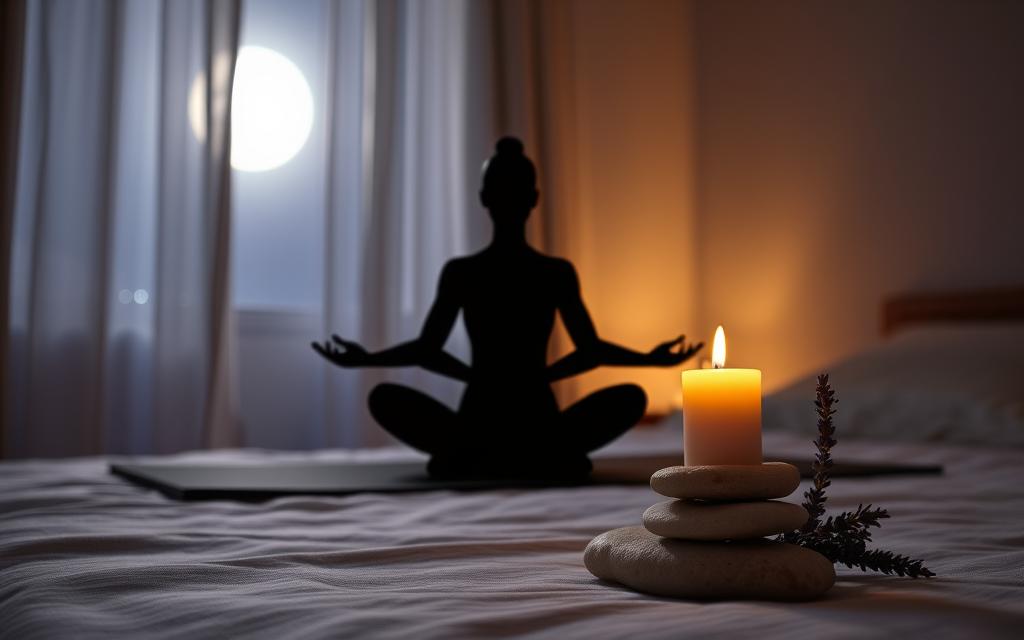
“Breath is the bridge which connects life to consciousness, which unites your body to your thoughts.” – Thich Nhat Hanh
Guided Visualization Methods
Struggling to fall asleep or stay asleep? Guided visualization can change the game. It’s a mental practice that lets you imagine peaceful scenes. These scenes can make you feel like you’re in a trance, similar to hypnosis.
As you picture these calm images, worries fade away. Your mind and body start to relax. This makes it easier to get deep, restful sleep.
Guided visualization is great for quieting your mind. By focusing on serene scenes, like a quiet beach or a green forest, you can stop racing thoughts. This mental relaxation helps you fall asleep more easily.
It also helps reduce stress and anxiety, which can disrupt sleep. As you dive into calming images, your body’s stress response slows down. This lets your nervous system relax, making it easier to sleep well.
- Find a quiet, comfy spot to relax without distractions.
- Close your eyes and picture a peaceful place, like a forest or a lake.
- Use all your senses to imagine the sights, sounds, and smells of this place.
- Breathe deeply and let the imagery techniques take you to a relaxed state.
- If your mind strays, gently bring it back to the visualization without judging.
- Keep this up for 5-10 minutes before bed to help you sleep better.
Adding guided visualization to your bedtime routine can be very helpful. It uses your imagination to bring calm and relaxation. This prepares you for a restful, refreshing night’s sleep.
“Guided imagery has been shown to assist with managing pain after orthopedic surgery, as per a 2017 review.”
Creating the Perfect Sleep Environment
Making your bedroom the perfect place for sleep is key. It’s about keeping the room cool and quiet. These steps can really help you sleep better.
Optimal Room Conditions
A cool, dark, and quiet room is the goal. Use blackout curtains to block out light. Keep the room at 60-67°F (15-19°C) for better sleep.
White noise machines or earplugs can help keep it quiet. Remove all electronic devices to avoid blue light. Choose comfy bedding and pillows for relaxation.
Minimizing Sleep Disturbances
Reducing sleep disruptions is also important. Avoid heavy foods before bed to prevent discomfort. Limit caffeine and alcohol in the evening for better sleep.
Try relaxation techniques like meditation or deep breathing before bed. A calm bedroom and soothing routines can help you sleep well.
“The bedroom should be reserved for sleep and sex. It’s not a workspace, it’s not a entertainment room. It’s a place for rest and peace.”
– Sleep Expert, Dr. Michael Breus
Establishing a Pre-Sleep Meditation Routine
Creating a bedtime routine is key for better sleep. Adding a short mindfulness meditation or body scan to your sleep schedule helps. It tells your body it’s time to relax and sleep well.
Begin by dimming the lights and turning off screens an hour before bed. Do quiet activities like reading, stretching, or journaling. This helps clear your mind of the day’s worries.
Then, find a comfy spot to sit or lie down. Take deep breaths to calm yourself.
- Try a short, guided meditation on breathing or a body scan. It makes you aware of your body and releases tension.
- Write in your journal about your day. Share any concerns or feelings you want to let go of.
- Do some gentle yoga or tai chi to calm your body and mind.
Having a regular wind-down routine tells your body it’s time to sleep. This pre-sleep ritual can make your sleep better. You’ll wake up feeling refreshed and ready to go.
Incorporating Mindfulness into Bedtime Habits
As the sun sets, it’s time to add mindfulness to your evening. This makes your bedtime routine more peaceful. It helps you relax and sleep better.
Evening Mindfulness Practices
Begin by adding mindful evenings to your day. Take a moment to think about your day. Let go of worries and stress. Use gratitude meditation to feel thankful and calm before sleep.
- Do a body scan meditation to relax your muscles.
- Try diaphragmatic breathing to calm your mind and heart.
- Get lost in a guided visualization to a calm place.
Transitioning from Day to Night
As bedtime approaches, aim for a calm sleep transition. Cut down on screen time and use blue-blocking glasses. Eat a light dinner three hours before bed.
Use relaxation techniques like reading or listening to music. A warm bath can also help you relax. These activities tell your body it’s time to sleep.
“Mindfulness is not about changing your life. It’s about living your life.” – Jon Kabat-Zinn
Adding mindfulness to your bedtime routine makes sleep better. With regular practice, you’ll sleep more easily. You’ll wake up feeling refreshed and ready to go.
Common Challenges and Solutions
Starting a sleep meditation journey can be rewarding but comes with challenges. Many face racing thoughts, physical discomfort, and irregular schedules. These can make it hard to get a good night’s sleep. But, with the right strategies, you can overcome these obstacles.
One big issue is when your mind wanders during meditation. To stay focused, try guided meditations with a soothing voice. This helps keep your attention. Also, adjusting your posture or using pillows can help with physical discomfort, letting you focus better.
Keeping a regular sleep meditation schedule can be tough. To beat this, set a consistent sleep schedule and make meditation a must-do part of your bedtime routine. If meditation is hard, start with short sessions. Then, slowly increase the time as you get more comfortable.
“Meditation is not about forcing yourself to be calm or still. It’s about allowing yourself to be calm and still.” – Deepak Chopra
If you have ongoing insomnia, see a healthcare provider or sleep specialist. They can check for medical issues and give you tailored advice to improve your sleep.
Remember, overcoming sleep and meditation challenges takes time. Be patient, try different methods, and celebrate small wins. With regular practice and a willingness to adjust, you can fully enjoy the benefits of sleep meditation and get better sleep.
Combining Sleep Meditation with Other Natural Sleep Aids
For better sleep, try mixing sleep meditation with other natural remedies. Herbal teas like chamomile, valerian root, and lavender can calm you down before bed. Supplements like melatonin and magnesium might also help improve your sleep. But, always talk to your doctor before trying new supplements.
Regular exercise is good for sleep, but avoid it close to bedtime. It can keep you awake. Also, keep your sleep schedule regular and avoid caffeine in the evening. These habits can boost your sleep meditation’s effects.
If you have chronic insomnia, consider cognitive behavioral therapy for insomnia (CBT-I). It’s a therapy that works with sleep meditation. CBT-I tackles the thoughts and habits that mess with your sleep. It offers a complete solution for better sleep.
